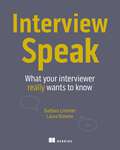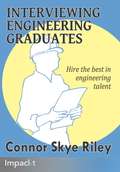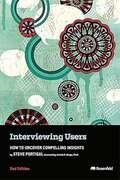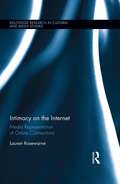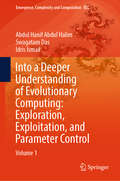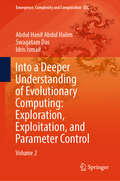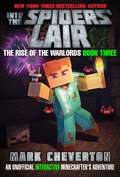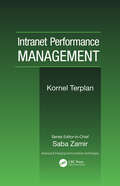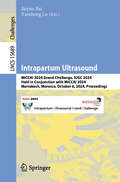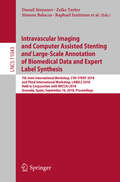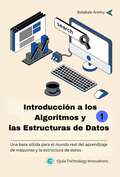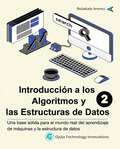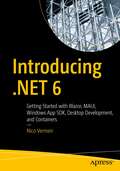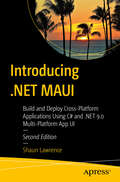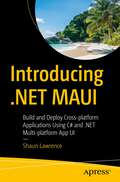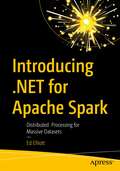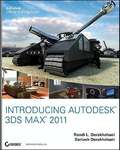- Table View
- List View
Interval-Valued Intuitionistic Fuzzy Sets (Studies in Fuzziness and Soft Computing #388)
by Krassimir T. AtanassovThe book offers a comprehensive survey of interval-valued intuitionistic fuzzy sets. It reports on cutting-edge research carried out by the founder of the intuitionistic fuzzy sets, Prof. Krassimir Atanassov, giving a special emphasis to the practical applications of this extension. A few interesting case studies, such as in the area of data mining, decision making and pattern recognition, among others, are discussed in detail.The book offers the first comprehensive guide on interval-valued intuitionistic fuzzy sets. By providing the readers with a thorough survey and important practical details, it is expected to support them in carrying out applied research and to encourage them to test the theory behind the sets for new advanced applications. The book is a valuable reference resource for graduate students and researchers alike.
Interval-Valued Methods in Classifications and Decisions (Studies in Fuzziness and Soft Computing #378)
by Urszula BentkowskaThis book describes novel algorithms based on interval-valued fuzzy methods that are expected to improve classification and decision-making processes under incomplete or imprecise information. At first, it introduces interval-valued fuzzy sets. It then discusses new methods for aggregation on interval-valued settings, and the most common properties of interval-valued aggregation operators. It then presents applications such as decision making using interval-valued aggregation, and classification in case of missing values. Interesting applications of the developed algorithms to DNA microarray analysis and in medical decision support systems are shown. The book is intended not only as a timely report for the community working on fuzzy sets and their extensions but also for researchers and practitioners dealing with the problems of uncertain or imperfect information.
Interview Speak: What your interviewer really wants to know
by Barbara Limmer Laura BrowneDiscover how to decipher the most important job interview questions so you can tell your interviewer what they really want to know.Interview Speak shows you how to ace job interviews by answering the questions behind the questions. Written for job seekers in any field, Interview Speak shows you how to draw on your own unique skillset and deliver answers that will make you stand out. In Interview Speak you&’ll learn how to: • Break down questions from the interviewer&’s point of view • Anticipate potential questions from a job description • Develop authentic answers that make you stand out • Navigate different interview stages • Recognize and respond to different types of interview questions Ever felt like you needed a translation guide for a job interview? Interview Speak is that book! From &“what are your weaknesses&” to &“what salary are you looking for&”, &“why did you leave your last job&” to &“what questions do you have&”, you&’ll learn what employers are looking for when they ask these questions and how to give the best answer for you. Have you ever left an interview thinking &“nailed it!&” and all you heard back was a short rejection? What happened? Didn&’t you say all the right things? Here&’s the hard truth: probably not! Job recruiters, screeners, and interviewers speak their own language. If you want to know what they&’re really asking, you need to learn interview speak! About the book Interview Speak translates the most common, important, and difficult interview questions into plain English and reveals how to answer them effectively and authentically. Experienced interview coaches and employment consultants Barbara Limmer and Laura Browne decode dozens of interview transcripts—including a few clueless responses that may seem all-too familiar. You&’ll learn to appear confident and qualified as you turn your good answers into great ones. What's inside • An insider&’s perspective on the job interview • Dozens of sample answers to common questions • No canned replies—develop your own authentic responses About the reader For job seekers in any field. About the author Barbara Limmer has personally coached thousands of professionals and executives from around the world. Laura Browne has extensive experience in leadership and management development, including time as Senior Director of Human Resources for a global tech company. Table of Contents Part 1 1 Welcome to Interview Speak Part 2 2 Common questions and special situations 3 Interpersonal skills questions 4 Perseverance skills, failures, and negative situations questions 5 Leadership, hiring, and motivating skills questions 6 Problem-solving, time management, negotiation, and change questions 7 Questions by job function Part 3 8 Not doing your homework, not being real, or leaving without 9 Not hearing the question, the whole question, and the heart of the question 10 Giving answers that sound good to you (but aren&’t) Part 4 11 Interview stages and translations before, during, and after 12 How to deal with bad interviewers (and really good ones) Part 5 13 Next steps A Interview questions by chapter B Questions to think about C Interview preparation checklist D Post-interview evaluation
Interviewing Engineering Graduates
by Connor Skye RileyA strong engineering team is the backbone of any technical company, and smart managers are always looking to hire top talent. Recruiting and interviewing engineers in a smart way is essential to the growth of your team and your company. In this saturated hiring market, your positions must stand out among the big name companies, and your hiring processes must be rigorous, fair and efficient. This comprehensive guide will show you how to hire outstanding technical employees. With its step-by-step instructions and examples, Interviewing Engineering Graduates will take you all the way through the process, from attracting great candidates to making hiring decisions with confidence. Hiring engineers is a complex, expensive and crucial process. This book will get you organized quickly and prepare you to make the right decisions every step of the way. First, you’ll see how to market your open jobs effectively through writing amazing job descriptions, and selling your company to top engineers so that you get the best applicants. You’ll then learn to narrow the field by identifying the best resumes. Using our tips, tricks and templates, you can design, plan and prepare thoroughly for smooth running, multi-stage assessments and interviews. Finally, you’ll easily identify which engineers will be top performers for your company, get your whole team involved in the hiring decision, and clinch that final offer! Whatever your company and whatever type of engineering job you’re hiring for, with this book you can hire employees with the technical savvy and teamwork skills to help take your organization to the next level.
Interviewing Users
by Steve PortigalInterviewing is a foundational user research tool that people assume they already possess. Everyone can ask questions, right? Unfortunately, that's not the case. Interviewing Users provides invaluable interviewing techniques and tools that enable you to conduct informative interviews with anyone. You'll move from simply gathering data to uncovering powerful insights about people.
Interviewing Users (2nd Edition): How to Uncover Compelling Insights
by Steve PortigalInterviewing is easy, right? Anyone can do it… but few do it well enough to unlock the benefits and insights that interviewing users and customers can yield. <P> In this new and updated edition of the acclaimed classic Interviewing Users, Steve Portigal quickly and effectively dispels the myth that interviewing is trivial. He shows how research studies and logistics can be used to determine concrete goals for a business and takes the reader on a detailed journey into the specifics of interviewing techniques, best practices, fieldwork, documentation, and how to make sense of uncovered data. Then Steve takes the process even further―showing the methods and details behind asking questions―from the words themselves to the interviewer’s actions and how they influence an interview. There is even a chapter on making sure that information gleaned from the research study is used by the business in such a way to make it impactful and worthwhile. Oh, and for good measure he throws in information about Research Operations. <P> But, hey, that’s just the nuts and bolts of the book. The truly fun part is Steve’s voice and how he portrays this information through amusing anecdotes about his career, fascinating examples from other practitioners, and tips and tricks that only the most experienced UX researchers, like Steve, could come up with. As a nod to the pandemic, he offers ideas for the best way to interview someone remotely, and he also discusses personal bias―how to identify and deal with it so that it doesn’t affect interviews.
Intimacy on the Internet: Media Representations of Online Connections (Routledge Research in Cultural and Media Studies)
by Lauren RosewarneThe focus of this book is on the media representations of the use of the Internet in seeking intimate connections—be it a committed relationship, a hook-up, or a community in which to dabble in fringe sexual practices. Popular culture (film, narrative television, the news media, and advertising) present two very distinct pictures of the use of the Internet as related to intimacy. From news reports about victims of online dating, to the presentation of the desperate and dateless, the perverts and the deviants, a distinct frame for the intimacy/Internet connection is negativity. In some examples however, a changing picture is emerging. The ubiquitousness of Internet use today has meant a slow increase in comparatively more positive representations of successful online romances in the news, resulting in more positive-spin advertising and a more even-handed presence of such liaisons in narrative television and film. Both the positive and the negative media representations are categorised and analysed in this book to explore what they reveal about the intersection of gender, sexuality, technology and the changing mores regarding intimacy.
Into a Deeper Understanding of Evolutionary Computing: Volume 1 (Emergence, Complexity and Computation #50)
by Swagatam Das Abdul Hanif Abdul Halim Idris IsmailThis book delves into fundamental and advanced strategies for enhancing evolutionary and metaheuristic algorithms, focusing on the crucial balance between exploration and exploitation in search mechanisms. As technological advancements increase optimization complexity, effectively managing this balance becomes essential for achieving optimal solutions within reasonable computational resources. The book's distinctive structure organizes content according to optimization stages and processes, offering a comprehensive discussion of various approaches supported by extensive literature. The authors note a scarcity of literature addressing the trade-offs between exploration and exploitation with contemporary references, making this work particularly valuable. It aims to deepen the reader's understanding of evolutionary computing, emphasizing exploration, exploitation, and parameter control. It is relevant not only to algorithm developers and the evolutionary computation community but also to students and researchers across scientific disciplines. The book is designed to be accessible to those without extensive algorithm development backgrounds, providing theoretical and practical insights into optimization methods.
Into a Deeper Understanding of Evolutionary Computing: Volume 2 (Emergence, Complexity and Computation #51)
by Swagatam Das Abdul Hanif Abdul Halim Idris IsmailThis book delves into fundamental and advanced strategies for enhancing evolutionary and metaheuristic algorithms, focusing on the crucial balance between exploration and exploitation in search mechanisms. As technological advancements increase optimization complexity, effectively managing this balance becomes essential for achieving optimal solutions within reasonable computational resources. The book's distinctive structure organizes content according to optimization stages and processes, offering a comprehensive discussion of various approaches supported by extensive literature. The authors note a scarcity of literature addressing the trade-offs between exploration and exploitation with contemporary references, making this work particularly valuable. It aims to deepen the reader's understanding of evolutionary computing, emphasizing exploration, exploitation, and parameter control. It is relevant not only to algorithm developers and the evolutionary computation community but also to students and researchers across scientific disciplines. The book is designed to be accessible to those without extensive algorithm development backgrounds, providing theoretical and practical insights into optimization methods.
Into the Spiders' Lair: The Rise of the Warlords Book Three: An Unofficial Minecrafter's Adventure (Rise of the Warlords #3)
by Mark ChevertonThe witches of the Far Lands of Minecraft are missing . . . all of them! When a young village girl is badly injured, and only a witch can help her, Watcher and his friends quickly discover there are spiders involved. They must follow clues leading them through jungles and forests, all the way to the doorstep of the dreaded outcast spiders, the Forgotten. Watcher and his companions must figure out a way to free the witches from their ruthless captors, but can they escape the Lair of the Forgotten in time to save the girl?The Rise of the Warlords series is a Minecraft adventure like never before, giving fans the option to play along in Minecraft as they read on custom Far Lands worlds exclusively designed by bestselling author Mark Cheverton.
Into the Wild: Beyond the Design Research Lab (Studies in Applied Philosophy, Epistemology and Rational Ethics #48)
by Andy Crabtree Alan ChamberlainThis edited collection opens up new intellectual territories and articulates the ways in which academics are theorising and practicing new forms of research in ‘wild’ contexts. Many researchers are choosing to leave the familiarity of their laboratory-based settings in order to pursue in-situ studies ‘in the wild’ that can help them to better understand the implications of their work in real-world settings. This has naturally led to ethical, philosophical and practical reappraisals with regard to the taken for granted lab-based modus operandi of scientific, cultural and design-based ways of working. This evolving movement has led to a series of critical debates opening up around the nature of research in the wild, but up until now these debates have not been drawn together in a coherent way that could be useful in an academic context. The book brings together applied, methodological and theoretical perspectives relating to this subject area, and provides a platform and a source of reference material for researchers, students and academics to base their work on. Cutting across multiple disciplines relating to philosophy, sociology, ethnography, design, human–computer interaction, science, history and critical theory, this timely collection appeals to a broad range of academics in varying fields of research.
Intranet Performance Management (Advanced And Emerging Communications Technologies Ser. #7)
by Kornel TerplanTo avoid serious bottlenecks, components of the Internet and of intranets-such as servers, browsers, and the access networks-must be properly designed, implemented, managed, and monitored. Beginning with the basics, Intranet Performance Management sets forth the standards, methods, and tools that can simplify and unify systems and network management, avoid the seemingly inherent problems associated with them, and contain costs.In this book, world reknowned expert Kornel Terplan addresses: Proactive server, browser, and access network monitoring Managing and authoring home page content Traffic management and load balancing in the access networks Reviewing and evaluating usage statistics using log filesThese tasks-essential to the success of an intranet-require the active and diligent work of the management team. Effective performance of these tasks allows for the use of inexpensive browsers, facilitates education, and improves Internet culture and scalability.
Intrapartum Ultrasound: MICCAI 2024 Grand Challenge, IUGC 2024, Held in Conjunction with MICCAI 2024, Marrakesh, Morocco, October 6, 2024, Proceedings (Lecture Notes in Computer Science #15689)
by Jieyun Bai Yaosheng LuThis LNCS book constitutes the proceedings of the MICCAI 2024 Grand Challenge on Intrapartum Ultrasound, IUGC 2024, which was held in conjunction with MICCAI 2024, in Marrakesh, Morocco, during October 6, 2024. The 9 full papers included in this book were carefully reviewed and selected from 15 submissions. The proceedings comprise papers submitted by participants to describe their innovative solutions for automating fetal head station assessment using intrapartum ultrasound imaging, based on the official dataset released for this challenge.
Intravascular Imaging and Computer Assisted Stenting and Large-Scale Annotation of Biomedical Data and Expert Label Synthesis: 7th Joint International Workshop, CVII-STENT 2018 and Third International Workshop, LABELS 2018, Held in Conjunction with MICCAI 2018, Granada, Spain, September 16, 2018, Proceedings (Lecture Notes in Computer Science #11043)
by Emanuele Trucco Eric Granger Pierre Jannin Su-Lin Lee Diana Mateus Lena Maier-Hein Veronika Cheplygina Simone Balocco Guillaume Zahnd Stefanie Demirci Luc Duong Shadi Albarqouni Danail Stoyanov Zeike Taylor Anne Martel Raphael Sznitman Stefano MoriconiThis book constitutes the refereed joint proceedings of the 7th Joint International Workshop on Computing and Visualization for Intravascular Imaging and Computer Assisted Stenting, CVII-STENT 2018, and the Third International Workshop on Large-Scale Annotation of Biomedical Data and Expert Label Synthesis, LABELS 2018, held in conjunction with the 21th International Conference on Medical Imaging and Computer-Assisted Intervention, MICCAI 2018, in Granada, Spain, in September 2018. The 9 full papers presented at CVII-STENT 2017 and the 12 full papers presented at LABELS 2017 were carefully reviewed and selected. The CVII-STENT papers feature the state of the art in imaging, treatment, and computer-assisted intervention in the field of endovascular interventions. The LABELS papers present a variety of approaches for dealing with few labels, from transfer learning to crowdsourcing.
Intravascular Imaging and Computer Assisted Stenting, and Large-Scale Annotation of Biomedical Data and Expert Label Synthesis
by Eric Granger Su-Lin Lee M. Jorge Cardoso Gustavo Carneiro Diana Mateus Tal Arbel Lena Maier-Hein Veronika Cheplygina Simone Balocco Guillaume Zahnd Stefanie Demirci Luc Duong Marc-André Carbonneau Shadi AlbarqouniThis book constitutes the refereed joint proceedings of the 6th Joint International Workshop on Computing and Visualization for Intravascular Imaging and Computer Assisted Stenting, CVII-STENT 2017, and the Second International Workshop on Large-Scale Annotation of Biomedical Data and Expert Label Synthesis, LABELS 2017, held in conjunction with the 20th International Conference on Medical Imaging and Computer-Assisted Intervention, MICCAI 2017, in Québec City, QC, Canada, in September 2017. The 6 full papers presented at CVII-STENT 2017 and the 11 full papers presented at LABELS 2017 were carefully reviewed and selected. The CVII-STENT papers feature the state of the art in imaging, treatment, and computer-assisted intervention in the field of endovascular interventions. The LABELS papers present a variety of approaches for dealing with few labels, from transfer learning to crowdsourcing.
Intrinsically Motivated Learning in Natural and Artificial Systems
by Marco Mirolli Gianluca BaldassarreIt has become clear to researchers in robotics and adaptive behaviour that current approaches are yielding systems with limited autonomy and capacity for self-improvement. To learn autonomously and in a cumulative fashion is one of the hallmarks of intelligence, and we know that higher mammals engage in exploratory activities that are not directed to pursue goals of immediate relevance for survival and reproduction but are instead driven by intrinsic motivations such as curiosity, interest in novel stimuli or surprising events, and interest in learning new behaviours. The adaptive value of such intrinsically motivated activities lies in the fact that they allow the cumulative acquisition of knowledge and skills that can be used later to accomplish fitness-enhancing goals. Intrinsic motivations continue during adulthood, and in humans they underlie lifelong learning, artistic creativity, and scientific discovery, while they are also the basis for processes that strongly affect human well-being, such as the sense of competence, self-determination, and self-esteem. This book has two aims: to present the state of the art in research on intrinsically motivated learning, and to identify the related scientific and technological open challenges and most promising research directions. The book introduces the concept of intrinsic motivation in artificial systems, reviews the relevant literature, offers insights from the neural and behavioural sciences, and presents novel tools for research. The book is organized into six parts: the chapters in Part I give general overviews on the concept of intrinsic motivations, their function, and possible mechanisms for implementing them; Parts II, III, and IV focus on three classes of intrinsic motivation mechanisms, those based on predictors, on novelty, and on competence; Part V discusses mechanisms that are complementary to intrinsic motivations; and Part VI introduces tools and experimental frameworks for investigating intrinsic motivations.The contributing authors are among the pioneers carrying out fundamental work on this topic, drawn from related disciplines such as artificial intelligence, robotics, artificial life, evolution, machine learning, developmental psychology, cognitive science, and neuroscience. The book will be of value to graduate students and academic researchers in these domains, and to engineers engaged with the design of autonomous, adaptive robots. The contributing authors are among the pioneers carrying out fundamental work on this topic, drawn from related disciplines such as artificial intelligence, robotics, artificial life, evolution, machine learning, developmental psychology, cognitive science, and neuroscience. The book will be of value to graduate students and academic researchers in these domains, and to engineers engaged with the design of autonomous, adaptive robots.
Intrinsically Motivated Learning in Natural and Artificial Systems
by Marco Mirolli Gianluca BaldassarreIt has become clear to researchers in robotics and adaptive behaviour that current approaches are yielding systems with limited autonomy and capacity for self-improvement. To learn autonomously and in a cumulative fashion is one of the hallmarks of intelligence, and we know that higher mammals engage in exploratory activities that are not directed to pursue goals of immediate relevance for survival and reproduction but are instead driven by intrinsic motivations such as curiosity, interest in novel stimuli or surprising events, and interest in learning new behaviours. The adaptive value of such intrinsically motivated activities lies in the fact that they allow the cumulative acquisition of knowledge and skills that can be used later to accomplish fitness-enhancing goals. Intrinsic motivations continue during adulthood, and in humans they underlie lifelong learning, artistic creativity, and scientific discovery, while they are also the basis for processes that strongly affect human well-being, such as the sense of competence, self-determination, and self-esteem.This book has two aims: to present the state of the art in research on intrinsically motivated learning, and to identify the related scientific and technological open challenges and most promising research directions. The book introduces the concept of intrinsic motivation in artificial systems, reviews the relevant literature, offers insights from the neural and behavioural sciences, and presents novel tools for research. The book is organized into six parts: the chapters in Part I give general overviews on the concept of intrinsic motivations, their function, and possible mechanisms for implementing them; Parts II, III, and IV focus on three classes of intrinsic motivation mechanisms, those based on predictors, on novelty, and on competence; Part V discusses mechanisms that are complementary to intrinsic motivations; and Part VI introduces tools and experimental frameworks for investigating intrinsic motivations.The contributing authors are among the pioneers carrying out fundamental work on this topic, drawn from related disciplines such as artificial intelligence, robotics, artificial life, evolution, machine learning, developmental psychology, cognitive science, and neuroscience. The book will be of value to graduate students and academic researchers in these domains, and to engineers engaged with the design of autonomous, adaptive robots.The contributing authors are among the pioneers carrying out fundamental work on this topic, drawn from related disciplines such as artificial intelligence, robotics, artificial life, evolution, machine learning, developmental psychology, cognitive science, and neuroscience. The book will be of value to graduate students and academic researchers in these domains, and to engineers engaged with the design of autonomous, adaptive robots.
Introducción a los Algoritmos y las Estructuras de Datos 1: Una base sólida para el mundo real del aprendizaje de máquinas y la estructura de datos (Introducción a los Algoritmos y las Estructuras de Datos #1)
by Bolakale AremuBeneficios acerca del aprendizaje de algoritmos y estructuras de datos. Primero, te ayudarán a convertirte en un mejor programador. Otro beneficio es que te harán pensar más lógicamente. Además, te pueden ayudar a diseñar mejores sistemas para almacenar y procesar datos. También sirven como una herramienta para la optimización y solución de problemas. Como resultado, los conceptos de algoritmos y estructuras de datos son muy valiosos en cualquier campo. Por ejemplo, puedes utilizarlos cuando construyas una aplicación web o escribes software para otros dispositivos. Puedes utilizarlos para aprendizaje de máquinas y analíticas de datos, las cuales son actualmente dos áreas excitantes. Si eres un hacker, los algoritmos y las estructuras de datos en Python también son importantes para ti en cualquier parte. Ahora, cualquiera que sea tu estilo de aprendizaje preferido, te tendré cubierto. Si eres un aprendiz visual, te encantarán mis diagramas claros e ilustraciones a través de este libro. Si eres un aprendiz práctico, te encantarán mis lecciones de práctica, de manera que puedas obtener práctica con algoritmos y estructuras de datos de una forma práctica. Estructura del curso. Hay cinco volúmenes en este curso. Este es el volumen uno. En este volumen, tomarás una inmersión profunda en el mundo de los algoritmos. Con frecuencia incremental, los algoritmos comienzan a moldear nuestras vidas de muchas maneras - desde los productos que nos recomiendan, hasta los amigos en que interactuamos en los medios sociales, y aún más importante que los aspectos sociales, como las políticas, privacía y cuidado de la salud. Por lo tanto, la primera parte de este curso cubre lo que son los algoritmos, como trabajan, donde se les puede encontrar (en aplicaciones de la vida real). En el segundo volumen, trabajarás a través de la introducción de las estructuras de datos. Aprenderás acerca de las e
Introducción a los Algoritmos y las Estructuras de Datos 2: Una base sólida para el mundo real del aprendizaje de máquinas y análisis de datos (Introducción a los Algoritmos y las Estructuras de Datos #2)
by Bolakale AremuIntroducción a Algoritmos y Estructuras de Datos - Volumen 2 Este libro es el segundo volumen de una serie titulada Introducción a los Algoritmos y Estructuras de Datos. El diseño de un algoritmo eficiente para la solución de problemas requiere la inclusión de las estructuras de datos apropiadas. En el campo de la ciencia de la computación, las estructuras de datos se utilizan para organizar y almacenar datos de una forma que sea más fácil de entender y utilizar. Se utilizan para organizar y representar datos de una forma que sea más fácil a las computadoras recuperar y analizar. Estos son los bloques de construcción fundamentales que cualquier programador debe conocer acerca de cómo utilizarlos correctamente para construir tus propios programas.
Introducing .NET 6: Getting Started with Blazor, MAUI, Windows App SDK, Desktop Development, and Containers
by Nico VermeirWelcome to .NET 6, Microsoft’s unified framework that converges the best of the modern and traditional .NET Framework. This book will introduce you to the new aspects of Microsoft’s fully supported .NET 6 Framework and will teach you how to get the most out of it. You will learn about the progress to one unified .NET, including MAUI and the revival of desktop development. You will dive into Roslyn, Blazor, CLI, Containers, Cloud, and much more, using a “framework first” learning approach. You will begin by learning what each tool is, its practical uses, and how to apply it and then you will try it out on your own for learning reinforcement. And, of course, there will be plenty of code samples using C# 10.Introducing .NET 6 is aimed at .NET developers, both junior developers and those coming from the .NET framework, who want to understand everything the modern framework has to offer, besides the obvious programming languages. While you will still see a lot of fabulous C# 10 throughout the book, the focus of this learning is all about .NET and its tooling.What You Will LearnBecome a more versatile developer by knowing the variety of options available to you in the .NET 6 framework and its powerful toolingKnow the different front-end frameworks .NET offers, such as UWP, WPF, and WinForms, and how they stack up to each otherUnderstand the different communication protocols, such as REST and gRPC, for your back-end servicesDiscover the secrets of cloud-native development, such as serverless computing with Azure Functions and deploying containers to Azure Container ServicesMaster the command line, take your skill set to the cloud, and containerize your .NET 6 app Who This Book Is ForBoth students and more experienced developers, C# developers who want to learn more about the framework they use, developers who want to be more productive by diving deeper into the tooling that .NET 6 brings to the fold, developers who need to make technical decisions. A working knowledge of C# is recommended to follow the examples used in the book.
Introducing .NET MAUI: Build and Deploy Cross-Platform Applications Using C# and .NET 9.0 Multi-Platform App UI
by Shaun LawrenceInterested in giving Microsoft’s new Multi-platform App UI (MAUI) a try? This book provides developers with a comprehensive set of tools and hands-on coding to build their own cross-platform applications. The book is a comprehensive end-to-end guide on creating, building, and distributing .NET MAUI applications. As you walk through each new concept, .NET MAUI expert and Microsoft MVP Shaun Lawrence will show the concept's value and uses, and then have you apply it in a build-along application. You will work with this build-along application right up until you are ready to ship it to the relevant stores (e.g., App Store, etc.). The underlying theme through the book is to explain a key concept, show how to implement it directly in order to reinforce your understanding, and then show potential simplifications (e.g., alternative libraries) that can help you reduce the complexities of an applications code base. What You Will Learn Create a .NET MAUI application Apply commonly required techniques Apply more advanced techniques to make applications stand out Know what to consider when distributing applications to the relevant stores Take an application from concept through to production Who This Book Is For Developers who are new to .NET MAUI and cross-platform development. A basic knowledge of C# is required, but no prior knowledge using .NET MAUI is required. Experienced developers also will find the book useful as it covers topics key to modern day development (such as accessibility, performance, and distribution). Xamarin Forms developers will find the book useful as key features new to .NET MAUI that will aid in the migration from Xamarin Forms to .NET MAUI are explained. New To This Edition Gain insights on the latest updates to .NET MAUI with the release of version 9.0. Learn about features like AOT, Polly, MauiReactor, Shell, and more.
Introducing .NET MAUI: Build and Deploy Cross-platform Applications Using C# and .NET Multi-platform App UI
by Shaun LawrenceInterested in giving Microsoft’s new Multi-platform App UI (MAUI) a try? This book provides developers with a comprehensive set of tools and hands-on coding to build their own cross-platform applications.The book is a comprehensive end-to-end guide on creating, building, and distributing .NET MAUI applications. As you walk through each new concept, .NET MAUI expert and Microsoft MVP Shaun Lawrence will show the concept's value and uses, and then have you apply it in a build-along application. You will work with this build-along application right up until you are ready to ship it to the relevant stores (e.g., App Store, etc.). The underlying theme through the book is to explain a key concept, show how to implement it directly in order to reinforce your understanding, and then show potential simplifications (e.g., alternative libraries) that can help you reduce the complexities of an applications code base. What You Will LearnCreate a .NET MAUI applicationApply commonly required techniquesApply more advanced techniques to make applications stand outKnow what to consider when distributing applications to the relevant storesTake an application from concept through to production Who This Book Is ForDevelopers who are new to .NET MAUI and cross-platform development. A basic knowledge of C# is required, but no prior knowledge using .NET MAUI is required. Experienced developers also will find the book useful as it covers topics key to modern day development (such as accessibility, performance, and distribution). Xamarin Forms developers will find the book useful as key features new to .NET MAUI that will aid in the migration from Xamarin Forms to .NET MAUI are explained.
Introducing .NET for Apache Spark: Distributed Processing for Massive Datasets
by Ed ElliottGet started using Apache Spark via C# or F# and the .NET for Apache Spark bindings. This book is an introduction to both Apache Spark and the .NET bindings. Readers new to Apache Spark will get up to speed quickly using Spark for data processing tasks performed against large and very large datasets. You will learn how to combine your knowledge of .NET with Apache Spark to bring massive computing power to bear by distributed processing of extremely large datasets across multiple servers.This book covers how to get a local instance of Apache Spark running on your developer machine and shows you how to create your first .NET program that uses the Microsoft .NET bindings for Apache Spark. Techniques shown in the book allow you to use Apache Spark to distribute your data processing tasks over multiple compute nodes. You will learn to process data using both batch mode and streaming mode so you can make the right choice depending on whether you are processing an existing dataset or are working against new records in micro-batches as they arrive. The goal of the book is leave you comfortable in bringing the power of Apache Spark to your favorite .NET language. What You Will LearnInstall and configure Spark .NET on Windows, Linux, and macOS Write Apache Spark programs in C# and F# using the .NET bindingsAccess and invoke the Apache Spark APIs from .NET with the same high performance as Python, Scala, and REncapsulate functionality in user-defined functionsTransform and aggregate large datasets Execute SQL queries against files through Apache HiveDistribute processing of large datasets across multiple serversCreate your own batch, streaming, and machine learning programsWho This Book Is For.NET developers who want to perform big data processing without having to migrate to Python, Scala, or R; and Apache Spark developers who want to run natively on .NET and take advantage of the C# and F# ecosystems
Introducing Algorithms in C: A Step by Step Guide to Algorithms in C
by Luciano ManelliStudy elementary and complex algorithms with clear examples and implementations in C. This book introduces data types (simple and structured) and algorithms with graphical and textual explanations. In the next sections, you’ll cover simple and complex standard algorithms with their flowcharts: everything is integrated with explanations and tables to give a step-by-step evolution of the algorithms. The main algorithms are: the sum of three or n numbers in a loop, decimal-to-binary conversion, maximum and minimum search, linear/sequential search, binary search, bubble sort, selection sort, merging of two sorted arrays, reading characters from a file, stack management, and factorial and Fibonacci sequences. The last section of Introducing Algorithms in C is devoted to the introduction of the C language and the implementation of the code, which is connected to the studied algorithms. The book is full of screenshots and illustrations showing the meaning of the code. What You Will Learn Implement algorithms in C Work with variables, constants, and primitive and structured types Use arrays, stacks, queues, graphs, trees, hash tables, records, and files Explore the design of algorithms Solve searching problems, including binary search, sorting, and bubble/selection sort Program recursive algorithms with factorial functions and Fibonacci sequences Who This Book Is For Primarily beginners: it can serve as a starting point for anyone who is beginning the study of computer science and information systems for the first time.
Introducing Autodesk 3ds Max 2011
by Dariush DerakhshaniAn Autodesk Official Training Guide to 3ds Max 2011 3ds Max is a popular 3D animation-and-effects software used in movies, visual effects, games, cartoons, short films, commercials, and other animation. However, it also presents a number of challenges to newcomers. This introduction to the latest version breaks down the complexities of learning 3D software and walks you through the basics of modeling, texturing, animating, and using visual effects. Real-world examples from talented beginning 3ds max users motivate you to learn the software and helpful tutorials offer realistic, professional challenges for you to unravel. In addition, each chapter is richly illustrated with workflows to make learning 3ds max 2011 much easier and fn. Introduces you to the basics of modeling, texturing, animating, and incorporating visual effects using the latest version of 3ds Max software Features excellent tutorials, helpful examples, detailed workflows, and a companion Web site to enhance your learning experience Explains a variety of methods for solving real-world challenges and breaks down why certain methods are used Makes the transition of coming from other 3D software applications as smooth as possible Introducing 3ds Max 2011 takes a typically difficult subject and breaks into easily digestible pieces so you can confidently begin working with this 3D animation software today.


